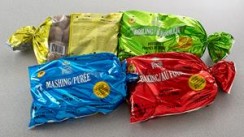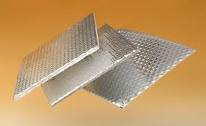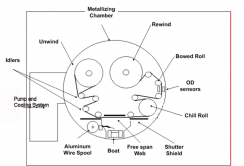
Looking for ways to increase barrier properties of your package? Here is some factors to consider when it comes to optimizing package barrier and improving production efficiencies. With high barrier metallized films offering barrier values in a range of 0.31– 0.46 g/m2/day water vapor barrier, and 0.31 – 0.46 cc/m2/day oxygen barrier, they can offer several advantages over foil in both production and final package integrity. 1. There is no question that metallized film offers better puncture resistance over foil. From the time the product is manufactured, packed and transported, the package will be flexed countless times and pin-hole and flex-cracking will occur. Though the product remains intact, foil barrier can be adversely affected by content vibration creating microscopic punctures. High barrier metallized films can improve shelf life over foil by resisting these punctures and retaining their high barrier properties. 2. Foil possesses dead-fold characteristics that make creases and wrinkles permanent. Making its way through the various channels to reach the store shelf, a package can look shopworn by the time it is in front of the consumer. Without the memory characteristics of foil, metallized films will withstand this handling, arriving on the store shelf with the fresh and original appearance and graphics intact. 3. Metallized film can run at faster line speeds compared to foil. Typically run at thinner […]

I often hear the questions: How does metallizing affect the yield or basis weight of flexible film? What is the thickness of aluminum applied? Even though vacuum metallizing can dramatically improve barrier values, the layer of metal is so thin that it does not alter the yield or mechanical properties of the film. Vacuum metallizing is a process where an alloy, such as aluminum, is melted and vaporized onto a receptive surface. Vacuum deposition takes place in a chamber under pressure well below atmospheric pressure. Unwind and rewind stations mounted in the chamber allow the film to pass from unwind to rewind over the active boat bed area. The aluminum is melted at 1500 degrees celsius and forms a vapor cloud above the boat bed. As the substrate passes over this active area, a thin layer of aluminum is deposited onto the film, creating a barrier layer. The aluminum thickness is measured in angstroms (Å), a unit of length equal to 10−10 m (one ten-billionth of a metre) or 0.1 nanometers (nm) and typically represents less than 0.1 percent of the base film. Generally, metal deposition in packaging applications ranges from 30.5 Å – 500 Å (3.5 – 50 nm). Metallizing a film typically increases barrier values 10-fold over non-coated/non-metallized film, so many people are surprised to learn that such […]
Vacuum metallizing takes place in a cylindrical chamber in which the air is pumped out via diffusion pumps to achieve an atmosphere much like that of the moon. Unwind and rewind stations are positioned in the chamber allowing the film to pass from unwind to rewind over the active boat bed area of the chamber, where aluminum is melted at 1500 degrees celsius and forms a vapor cloud above the boat bed. As the substrate passes over this active area, a thin layer of aluminum is deposited onto the film, thus creating a barrier layer. The aluminum coating is measured in angstroms and typically represents less than 0.1 percent of the base film and therefore does not affect the yield or mechanical properties of the base film.

March 2014 Packaging: Food & Beverage: Marketing Celplast Metallized Products The AIMCAL Marketing Award in the Food Packaging Category went to Celplast Metallized Products, Toronto, Ontario, Canada, for metallized, light-blocking low-density polyethylene (LDPE) bags for four varieties of potato from EarthFresh Farms, another Toronto-based firm. Celplast metallizes 1.25- or 1.75-mil LDPE from Tempo Plastics Ltd., Innisfil, Ontario, and returns it to Tempo for conversion into wicketed bags. Stripe metallizing provides product visibility while blocking most of the light that would reach the potatoes in a standard poly bag. Eliminating light exposure prevents the potatoes from turning green (and bitter) and more than triples shelf life to 21 days. Bags are punched with two parallel rows of ventilation holes and printed with bilingual product and brand information as well as alternate serving suggestions. Color coding identifies Roasting (gold), Boiling (green), Baking (red) and Mashing (blue) potatoes. Judges Comments Judges noted potato bags tend to be heavier gauge film or woven. “We really haven’t seen anything like this for fresh potatoes,” said one member of the panel. “It opens the door to greater use of metallized packaging in the produce department,” predicted another.
Cel-Met and O2 Barrier metallized sealants from Celplast permit down-gauging of approximately 25% without compromising the barrier properties or performance of the barrier laminate. The Cel-Met sealant replaces metallized oriented polypropylene to reduce a three-ply structure to two plies while providing an oxygen transmission rate (OTR) of 4.0 cubic centimeters per 100 square inches per day and a water vapor transmission rate (WVTR) of 0.08 grams per 100 square inches per day. The O2 Barrier sealant replaces metallized polyethylene terephthalate to convert a three-ply structure to a two-ply and provides even higher barrier properties: 0.04 cubic centimeters per 100 square inches per day OTR and 0.05 grams per 100 square inches per day WVTR. Eliminating the need for a second pass in the lamination process also conserves adhesive and reduces energy requirements 31% for solvent-based structures and 11% for solvent-less. Carbon dioxide emissions also drop: 34% for solvent-based laminating and 30% for solvent-less. Applications include stand-up and peg-display pouches. Judges Comments The judges noted the metallized sealants reduce steps in the process and achieve a significant source reduction. “It’s a new way of looking at structures and definitely a step in the right direction,” concluded one member of the panel. A detailed article on these Barrier Sealants is available on Converting Quarterly Magazine 2011 Quarter 2 p 56.

In the Industrial Category, Celplast received the Technical Award for its REFLECT-MET™ top-coated metallized PET, which is used in AstroShield material, a low emissivity product sold by Innovative Energy Inc., Lowell, Indiana, for applications requiring reflective insulation or a radiant barrier. Converted by Pregis Innovative Packaging Inc., Plymouth, Indiana, and used primarily in building construction and remodeling, the AstroShield options include REFLECT-MET™/bubble/bubble/Reflect-Met, Reflect-Met/white bubble or Reflect-Met/white bubble/white bubble. The coated metallized layer helps the lamination meet water vapor transmission, strength, thermal and fire performance requirements, while providing a brightness similar to foil. In fact, the REFLECT-MET™ layer meets reflective insulation standards for moisture corrosion resistance (ASTM D3310), vapor retarding (ASTM E-96), aged vapor retarding (ASTM C1258) and emissivity less than or equal to 0.05 (ASTM C1371). The coated metallized polyester also is significantly more machinable than thin-gauge foil because its resists the tear-outs and creasing that typically generate scrap rates ranging from 4% to 8% for foil laminations. Perhaps, most importantly, the REFLECT-MET™ metallized polyester meets pending changes to the ASTM E-84 flame test, which will render laminations using an unprotected foil layer unacceptable. Finally, the fiber-free lamination comes in easy-to-handle rolls, requires no custom installation tools, and eliminates the need for any special personal protection equipment. Although insulation is a big market for metallized material, the judges concluded, “We […]





